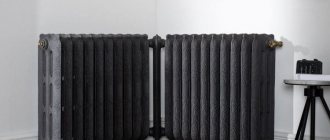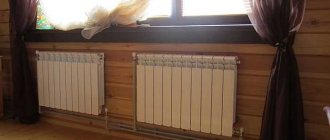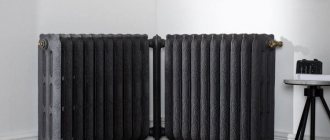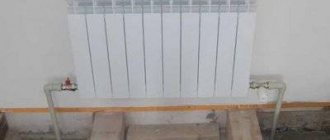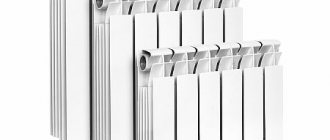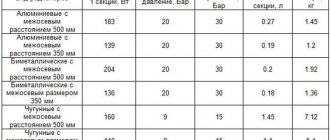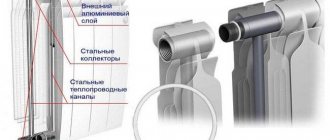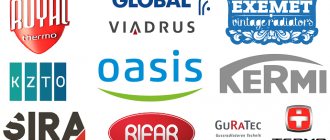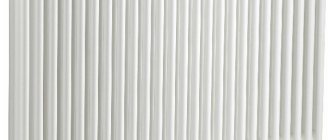Heating radiators in the house require mandatory painting. The best paint for radiators will protect surfaces from adverse external influences and give the room a presentable appearance. From the variety of coating options for pipes and heating radiators, it is better to choose paints and varnishes in accordance with the type of room, operating features, and surrounding design. Basic requirements for paint and varnish materials: durability, reliability of the coating without compromising the integrity of the outer layer during the stated period, resistance to sudden temperature changes, aesthetics, environmental safety without the release of unpleasant odors.
Types of paints for heating radiators
The aesthetics and beauty of painted heating radiators depend not only on the cost of paintwork materials, but also on the correct choice of paint based on its chemical composition. Manufacturers of paints and varnishes produce paints on various bases. When choosing the most suitable option for a particular battery, it is necessary to take into account the positive and negative characteristics of each substance.
Depending on the material used to make radiators, paints are selected from the following categories:
- Oily.
- Water-based.
- Alkyd.
- Silicone.
- Powder.
For the primary coat, glossy paint for heating pipes is recommended. The subsequent re-layer should be matte in order to hide possible defects and unevenness of the metal as much as possible.
The variety of paints suitable for painting radiators is truly surprising. In addition, products are constantly being improved, so it is recommended to study the available catalog and make the right choice.
Need to update
The service life of radiators made of cast iron or aluminum can exceed 50 years, but if the paint on old radiators in an apartment or kitchen has faded over time and began to swell, then in such an unpresentable form they clearly attract attention and can hardly be considered a home decoration
Solving the problem by replacing batteries due to the considerable cost of this method can hardly be considered the best option. And repainting the radiators can be a completely acceptable way out of the situation.
There are several factors to take into account:
- Not all types of heating radiators can be painted on your own at home. Often, especially if the dye is chosen incorrectly, it will either quickly turn yellow or peel off soon.
- Batteries, as you know, are made of cast iron, aluminum, steel, or can be bimetallic. In principle, painting cast iron radiators does not cause problems. Here everything depends only on the right choice of paint for this purpose. But in the case of aluminum radiators, convectors or batteries made of stainless steel, the situation looks different.
Such elements of the heating system are powder painted at the manufacturer, followed by heat treatment.
Therefore, applying a new layer of paint over the factory paint coating at home becomes a serious problem.
The vast majority of manufacturers of heating radiators not made of cast iron consider attempts to unauthorizedly paint batteries as a violation of the factory warranty by the consumer.
- If the consumer has successful experience in painting a car body and paint materials suitable for the task, then you can try to paint aluminum batteries. But otherwise it is better to abandon this idea. In this case, it is more advisable to buy new heating elements, or cover the peeling products with a decorative screen.
- A special point are steel convectors. They are equipped with frequent fins made of steel plates strung on a pair of pipes - the so-called “comb”. If you try to paint these plate fins, you will have the undesirable effect of a sharp decrease in heat transfer. It is also impossible to reach the pipes themselves with a narrow brush. Therefore, it is better to avoid painting these surfaces.
Such radiators are usually equipped with iron shutters and side screens. These elements not only can, but also need to be painted, and ordinary heat-resistant dyes are quite suitable for this purpose.
The best oil paints for radiators
Oil paints are no longer in demand, because they usually have a pronounced smell and the result obtained after a short time ceases to be noticeable. The main advantage is the affordable price category.
DekArt MA 15
These products are ideal for painting metal radiators. It is offered in different colors, so the heating device can be painted taking into account the features of the interior. Products are manufactured in Ukraine with mandatory consideration of current standards and basic quality requirements.
Pros:
- a high level of protection of heating batteries from adverse external factors is guaranteed;
- it is possible to give an attractive appearance to the radiator, focusing on the design features of the room;
- It is offered only in bright shades, thanks to which its special beauty is noted.
Minuses:
- At first, there may be a pronounced smell of paint and varnish products.
Oil-phthalic enamel Sniezka Supermal
Suitable for painting steel and cast iron batteries. Recommended for use in public spaces, including medical, educational, industrial. The Polish product has proven itself only from the best side.
Pros:
- increased resistance to adverse atmospheric and mechanical factors;
- optimal consumption, which ensures decent savings;
- the paint layer is particularly resistant to external factors, so long-term preservation of its original condition is guaranteed;
- bright colors, with 23 shades available to choose from;
- compliance with current standards, making the products ideal even for public buildings, including the medical sector.
Minuses:
- not detected.
- Such materials are of high quality, because technologies are gradually improving.
Recommendations for painting bimetallic and aluminum radiators
New bimetallic and aluminum batteries look good. But is it possible to update them to the same state, and even with the heating on, during the cold season? This is a question, because such structures are painted with special compounds and powders during manufacture. But what to do if the radiator has completely lost its appearance. It's worth trying to freshen it up a little.
First you need to remove the coating down to the metal. A sanding machine will help with this. After this it is necessary to carry out priming. Afterwards - painting with alkyd enamel.
Alkyd enamel
Or you can update the radiator's original appearance with powder coating at home. Unfortunately, this procedure cannot be performed. It turns out that you can buy special pigment powders, but you also need a special sprayer for it. But even if it were found, there would be no source of voltage that should have a specific value in the apartment. So, just like the temperature regime after painting is 170-350 degrees, we also cannot provide it.
The best water-based paints for radiators
Acrylic paint for heating radiators Radiator Festek
The products are offered by a Ukrainian manufacturer. The type of composition is one-component, but it guarantees increased resistance to the adverse effects of water. Allows you to improve the external condition of heating radiators thanks to a pleasant matte snow-white shade.
Pros:
- absence of any odors;
- increased resistance to water washing and dry abrasion;
- the ability to completely paint heating batteries without further influence of external factors;
- resistance to yellowing;
- the ability to withstand heating up to 95 degrees Celsius;
- minimal drying time, which speeds up the procedure.
Minuses:
- vulnerability to high operational loads
Washable odorless semi-matte paint Remontti Assa Tikkurila
These paint and varnish products are offered by a well-known Finnish manufacturer, which takes into account current standards and successfully produces high-quality modern paints for the further processing of heating batteries.
The composition is created using an acrylate binder. At the same time, the manufacturer refused to use organic solvents. This approach to the creation of paint and varnish products contributed to the receipt of the “Eco-label” of the European Union. The Association of Allergy and Asthmatic Disease Specialists of Finland participated in the development, as a result of which the products are completely safe even for allergy sufferers and asthmatics.
Pros:
- created from high-quality components and modern technologies;
- high level of safety, due to which the use of products is justified in most cases;
- resistance to washing and abrasion.
Minuses:
- very high price, so such products are not available to all potential buyers.
Acrylic enamel for heating radiators Farbex Polisan
The products are offered by the famous Ukrainian manufacturer Polisan, which tries to take into account current standards and offer only high-quality paints and varnishes. It is assumed that it is possible to carry out decorative and protective painting of heating devices.
Pros:
- requires minimal time to dry;
- It has a snow-white hue and a pleasant glossy finish, and the original color remains for a long time;
- optimal adhesion to various types of surfaces is guaranteed;
- there is increased resistance to frequent repeated washing;
- additional treatment with pigment concentrates is available, as a result of which the heating device can fit perfectly into the design of the room;
- no pungent odor;
- The content of volatile organic compounds complies with current standards, therefore the products are recognized as safe.
Minuses:
- the radiator must be thoroughly treated before further painting, and dust, rust, scale, grease and other contaminants must be excluded;
- surfaces that were previously painted with alkyd or oil paint must be carefully treated until matte and degreased;
- preparing paint requires a careful approach and effort, strict adherence to the instructions and certain room conditions (air humidity should not be lower than 80%, and the surface temperature should be from +10 degrees).
- Correct use of paint justifies its choice for further use and successful treatment of used heating radiators.
Paint for radiators Balakryl Radet
The Czech brand Balakryl offers high-quality paint that is ideal for treating heating radiators in modern heating systems of residential and industrial premises.
Pros:
- increased resistance to the adverse effects of water;
- possibility of use in rooms where there is a high level of humidity;
- The heat resistance exceeds 100 degrees, therefore the safety and long-term preservation of the original condition of the heating batteries is guaranteed.
Minuses:
- not identified.
The best alkyd paints for heating radiators
Tikkurila Empire
The paint is offered by a well-known Finnish manufacturer. A ready-made concentrate and a special thinner, white spirit, are used. Alkyd paint is semi-matte and high quality.
Pros:
- there is no risk of the slightest smudges when painting radiators;
- optimal adhesion to metal pipes is guaranteed;
- even the slightest odor is eliminated;
- there is the possibility of painting heating devices in the desired colors and shades;
- The paint layer is easily and quickly applied.
Minuses:
- requirements for indoor conditions (temperature should be from 5 degrees Celsius, air humidity – from 80%);
- thorough preparation of the radiator is required for further successful painting;
- relatively high consumption of the finished solution (10-12 liters per square meter).
SADOLIN MASTER 30
The Swedish manufacturer offers high-quality alkyd paint for metal batteries. The paintwork will have a semi-matte, pleasant shine.
Pros:
- guaranteed protection of the surface from rotting, corrosive changes, mildew and mold;
- even the slightest smudges are eliminated when treating batteries with paint;
- there is increased resistance to atmospheric influences;
- provides abrasion resistance;
- fits perfectly on almost any surface;
- can be painted in any color and shade.
Minuses:
- has a smell (weak, but you will need to ventilate the room after the event);
- high price.
Professional Gloss JOHNSTONE'S
High-quality paint from a British manufacturer is ideal for working with metal heating devices. The product is based on a durable alkyd resin that helps create a durable coating.
Pros:
- creating an ideal paint coating;
- pleasant shine due to the special texture of the paint;
- increased resistance to adverse external factors: temperature, shock.
Minuses:
- high price.
When choosing paint, it is advisable to take into account the features of its composition and main characteristics.
- Oil paints are offered at affordable prices. In addition, their range surprises with its diversity. You need to prepare for a long drying time and an unpleasant odor.
- Acrylic paints dry quickly and are odorless. However, the perfect color is not always obtained.
- Alkyd paints have increased resistance to high temperatures and adverse mechanical factors. However, when painting, there is a pronounced smell. In addition, it takes a long time to dry.
- Heat-resistant paints are ideal for hot batteries, because they do not turn yellow and can withstand even the highest temperatures.
There are a variety of battery paints available these days, so it is important to carefully review the available products, their features, pros and cons. By choosing the right paint and taking into account the basic recommendations when applying it, you can count on successfully updating the condition of your heating radiators.
Painting technology
Dyeing process:
- First of all, you need to cover the floor under the radiator with newspapers or other unnecessary material to prevent dye from penetrating it.
- You need to select 2 brushes and prepare special gloves. The brushes should have soft bristles: one is regular, and the other is curved (for painting hard-to-reach areas). The product is applied from top to bottom. Initially, the ceilings are painted inside, and then the remaining areas.
- When the first layer is applied, you need to wait until the dye hardens. After this, repainting is performed.
Radiators can be painted with any paint; it is important to choose the right composition and follow the application technology
Correct priming of heating devices
Battery priming involves the following steps:
- Initially, the previous paint is removed using special solutions and a spatula. Areas affected by rust are also cleaned.
- Using emery, you need to sand all rough edges and bring the battery coating to a smooth state.
- Then the surface of the device is degreased (white spirit is used for this).
- Finally, the battery is coated with a primer, which has anti-corrosion properties and improves paint adhesion to the surface of the structure.
Is it possible to paint hot radiators?
The influence of hot water will become a provoking factor in the early failure of batteries - as time passes, corrosion pockets are found on the metal coating. To prevent such a process, special types of paints and varnishes are used to paint radiators.
Important! High-quality paint must cope with elevated temperatures, have a stable film structure and retain its original color for a long period of time. In addition, when repairs are carried out in winter, it is advisable to choose a product without strong odors
Which battery paint is best to buy?
After reading the rating article, it becomes clear that radiators cannot be painted with the first paint you come across. Heat-resistant coatings must be used for heating pipes and radiators.
In order not to make a mistake in choosing the right paint and varnish material suitable for specific conditions, you need to familiarize yourself with the labeling and chemical composition of the selected product. The owner of the apartment decides which paint for pipes and radiators is best suited for a given room. At the same time, it doesn’t hurt to read the recommendations of experienced specialists and user reviews.



